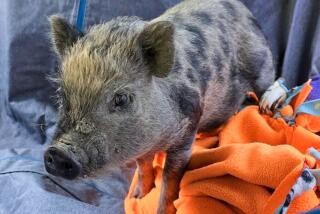These Little Piggies Could Eat You
- Share via
If the 1995 movie “Babe” and its 1998 sequel, “Babe: Pig in the City,” served up an easy-to-digest picture of squeaky clean porcine precociousness, two new movies give us less palatable images. The sweet, good-natured pigs depicted in the children’s classic “Charlotte’s Web” and the “Babe” movies have become the flesh-eating swine of “Snatch” and “Hannibal.”
After seeing James Cromwell’s benign Arthur Hoggett in “Babe,” a pig-farming gangster might be hard to swallow, but in “Snatch,” Guy Ritchie’s roller-coaster ride through London’s underworld, it makes perfect sense. As kingpin Brick Top (Alan Ford) comments, “Beware of any man who keeps a pig farm.” According to Brick Top’s calculations, if you cut up a corpse into six pieces, 16 starved pigs can go through 200 pounds of meat in about eight minutes. “They will go through bone like butter,” he asserts.
“Snatch” only features some relatively benign overhead shots of swine in their pens as Brick Top walks through the barn. “Hannibal,” on the other hand, has ground-level shots of wild pigs chomping on humans. In Thomas Harris’ novel “Hannibal,” the pigs are hybrids resulting from a seven-year breeding program involving the giant forest pig. Press material said those used in the movie were 450-pound Russian boars bred in Canada. (“Pig,” “hog,” “boar” and “swine” refer roughly to the same kind of animal, although boar in the U.S. commonly means a wild version, especially one with tusks.)
In the book and in the movie, the swine are conditioned to tear at a dummy packed with raw meat when they hear human screams. Of the 15 porcine performers in “Hannibal,” three were trained to grab and toss, and were strong enough to flip a 250-pound stuntman six feet in the air, according to press materials.
Reality is less cute and cuddly than “Babe,” but usually less horrific than “Snatch” or “Hannibal.”
Pigs, wild and domesticated, are omnivores; they eat meat and vegetables. Unlike dogs, they don’t run or hunt. But they are open to opportunity, and they are, like Dr. Lecter, cannibalistic. “They will eat about anything that’s in their pen. If one pig gets sick or dies, the others will eat it. Afterward, there might be a trace left--like a chunk of hide with the head attached,” according to Jerry Hackett, a veterinarian and coordinator of the animal health science program at Cal Poly Pomona.
Cannibalism isn’t unheard of among other animals. Under stressful conditions, many animals, including rats, chickens and even rabbits are known to cannibalize. But pig farmers generally trim the needle teeth that would later develop into tusks while the piglets are still nursing, in order to reduce cannibalism and fighting.
Hackett, who hasn’t seen either movie, said, “The gangster’s premise is not unreasonable, but the question is whether the pigs would consume the largest bones and the skull.” Hackett recalled that in pig-rearing parts of the United States, caretakers have been injured seriously or killed by pigs.
Dr. Edward Fonda, chairman of Cal Poly Pomona’s animal and veterinary sciences department, agreed, calling swine “eating machines.” Fonda who also had not caught either movie, said he didn’t think the hungry hogs would consume the femurs or the head. “Babe was presented as a meek little creature, very passive. It’s not very realistic,” Fonda said, adding that while hogs aren’t bloodthirsty, they are “very aggressive for food.”
“They are one of the most intelligent of farm animals; they are curious about new smells and tastes,” he said. “Swine will chew on the students working with them. They [the swine] start out shy and start to chew on shoes, shoelaces and pants. They try biting if you don’t force them to leave you alone.”
And although both Dr. Lecter and pigs like truffles, the pigs are less choosy about what they eat--more gourmand than gourmet. Fonda said, “They are opportunistic scavengers. They prefer food that gives the least resistance. But they won’t track down something and kill it.”
As for the behavior of wild pigs, according to Carmi Penny, curator of mammals at the San Diego Zoo, “Wild boar will generally not attack people unless they are being molested or for other due cause. There are, however, numerous accounts of attacks on people, usually when the boar is cornered or in defense of a litter of piglets. Boar and domestic pigs should always be treated as potentially dangerous animals. Wild pigs are generally smaller and more agile than the domestic pig. They would also be more likely to have their tusks.”
Penny wouldn’t comment on the “Hannibal” scenario, but Hackett said, “I have no doubt that if a restrained person was put in a pen, invariably, inevitably, the pigs would start eating that person.” Fonda agreed that should the opportunity present itself, the pig might stuff itself with a little human flesh, particularly if it were stressed from a few days of starvation, as presented in both movies.
So next time you meet a porcine gaze, it’s probably not thinking, “A kind and steady heart can heal a sorry world.” In fact, you and the pig might be thinking the same thing: “Yum yum.”
More to Read
Only good movies
Get the Indie Focus newsletter, Mark Olsen's weekly guide to the world of cinema.
You may occasionally receive promotional content from the Los Angeles Times.










